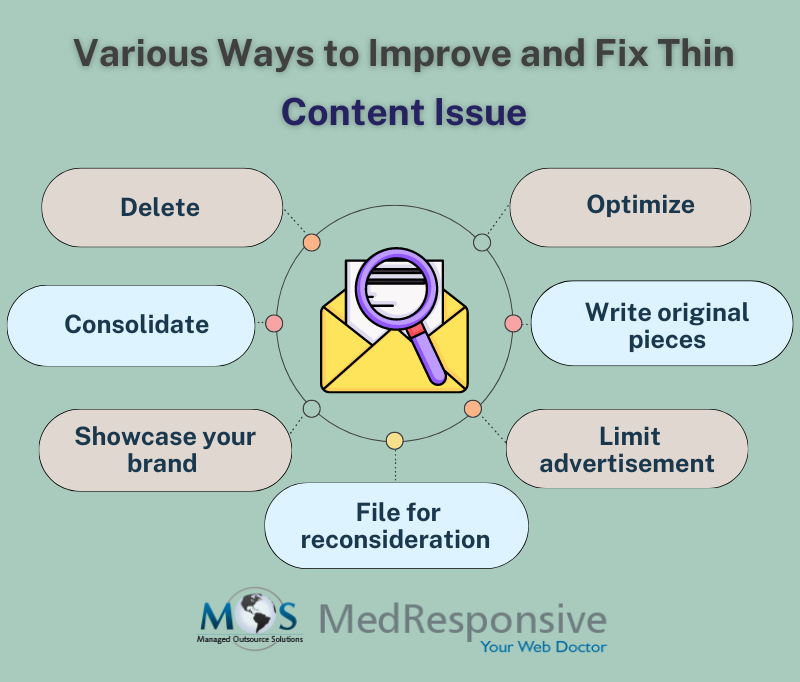How many times have you looked for a particular information on search engines, visited multiple websites, only having to leave feeling frustrated and annoyed with no answers? While there might be many articles or blogs published online, they often lack credible knowledge (don’t worry, this isn’t one of those!)
In this era of digitalization, high-quality content is the lifeline of any website and a key digital marketing strategy. However, digital marketers are often under pressure to churn out content after content on numerous topics in limited time. This in turn affects the quality of content delivered and the result is low-quality content that is of little or no value to the user. In the SEO industry, this issue is popularly termed as “thin content”. So, what exactly constitutes thin content and how does it correlate with the SERP ranking?
In the simplest words, any web page that contains shallow, insufficient content that provides visitors with little or no value is called thin content. There are various types of thin content such as pages with low word count (less than 200), duplicate pages, pages created automatically and heavy promotional content with low value. Though seemingly harmless on the surface, Google algorithm penalizes such content and it doesn’t rank well, thus lowering your website’s position in the SERP. That’s why it’s important to either avoid or fix this issue immediately as your website would suffer in ranking in the long run and negatively impact your success. An experienced digital marketing services company can help you identify and come up with solutions to fix any thin content issue that you may face on your site.
What is Thin Content?
To understand thin content, we need to learn the history behind it. Prior to 2011, by creating low-value content with the aid of keyword stuffing, cloaking and other shady link building tactics many websites ranked high in the search results. All that changed when Google’s first Panda algorithm update was implemented in 2011, which resulted in a sudden massive change in search results. The goal of this update was to lower the rank of low-value sites and return websites with high-quality content to the top of search results.
This update brought about a radical transformation in the field of SEO and digital marketing, as it had negatively impacted plenty of sites with low-quality content, mainly ones that contained a large amount of advertising. It also penalized duplicate, plagiarized content as well as user-generated spam that failed to provide relevant solutions to a user’s intended search query. Another update, unleashed in 2017 known as Fred update, refined the search results by targeting aggressive monetization tactics such as overloaded, deceptive ads, link schemes and thin content in order to provide better user experience.
Although Google’s algorithm updates implemented over the years have become increasingly sophisticated and user-focused, the above two are the main ones that focused on thin content. Every update now is based on the E-A-T guidelines, defined by Google as “Expertise, authoritativeness, and trustworthiness of the creator of the main content, the main content itself, as well as the website.” So, for each search query asked by searchers, Google’s intent is to provide a comprehensive list of results that aligns with the search purpose.
According to Google, thin content is “low-quality or shallow pages on your site”. Here, content doesn’t necessarily refer to just text or its length, but also images, videos, headers, multimedia, navigation tools and overall elements of a website. The value of content is what’s meant by “thin” content, that is, if Google’s algorithm detects page content which is scraped, duplicate, auto-generated, stuffed with keywords and filled with ads or spammy links, even if it’s over 2000-word blog, chances are it’s most likely to be branded as “thin” content page. Once detected for thin page issue, your website suffers from low rankings, high bounce rate, less organic backlinks and other problems as well. The thin content penalty is risky as it could lead to your website being removed from the search results entirely and you’d have to submit a reconsideration request to Google after fixing the cause of the penalty. It may be a difficult job for you as an SEO beginner to find a solution for this issue, that’s why it’s better to enlist the services of a content writing services agency to replace old, low-quality content with new, improved content that adds value to your website.
Types of Thin Content
Here are the different types of pages which Google typically considers as thin content:
- Thin affiliate pages – They are in the simplest term, useless content that doesn’t offer any real insight or information to the user. If your content fails to provide high-quality answers to user queries, then it’s deemed as thin affiliate site.
- Duplicate pages – If your website contains several pages that repeat the same information or if it’s identical to any other third-party website, your site lacks uniqueness and Google will classify it as thin content.
- AI-generated content – Even though AI-generated content is the rage these days, if you completely use AI for content creation, your website may end up with keyword-stuffed, unnatural, false and nonsensical content that will be flagged as thin content.
- Overly promotional pages – Google has made it clear that sites filled with aggressive ads or popups are considered shallow and do not provide satisfactory user experience. Such content is also considered thin.
- Doorway pages – Doorway pages consist of low-quality content that essentially manipulates the user by filling the site content with keywords to rank for specific search queries but offers very little value.
How to Improve Thin Content Pages
There are certain steps you can take to resolve any thin content pages on your site and avoid thin content penalty:
- Delete
It may be tempting to delete everything and start fresh content for your site from scratch but it’s important to consider the keywords, phrases and texts that helped you rank in the search engine so far. After conducting a thorough research, see where your site ranks and what content is currently driving the most traffic to your site, and then get rid of thin pages that are not worth saving while keeping the rest for rework and improvement.
When you delete, a 301 redirect must be included to indicate permanently moved pages.
- Optimize
As you may have a few content pieces that need improvement, you can optimize this old content into effective new content by implementing keyword research strategy. Other updates include:
- Analyzing competitors’ ranking to see your standing
- Updating photos or videos
- Revising dated data such as statistics, infographics and graphs
- Identify relevant and new keywords to target
- Update call to action to align with your current marketing goals
Firstly, figure out your content’s message and use relevant keywords, with each keyword not repeating more than once. Use software tools to analyze the rankings of keywords and insert them strategically in relevant places where it makes sense to use keywords for SEO. These places include titles, Meta descriptions, subheadings, images, URLs and the main content of your website. Structured and formatted content not only enhances ranking but also the UX/UI of your site.
- Consolidate
When multiple thin pages with similar topics are present on your site, you can combine them into a single page which creates more value. Read through the articles to identify and sort them based on topic similarity, a single page of 2000 words ranks much better than when divided into multiple pages of 300 words. Before combining, find out what’s currently ranking for primary keyword and if there are same keywords, then it’s fit for combining. This practice of reusing or redefining some or all parts of existing content to strengthen the value and expand content reach is called repurposing. The key benefit of it is that you can develop high-quality content while dealing with time and resource constraints.
- Write original pieces
Although it is time-consuming hard work to write original content, it can ultimately pay off as users always prefer the latest, authentic and original content. You can do that by researching topics in your niche, crossing off topics you’ve already written about and selecting the handful of topics left that are associated with your site’s purpose. It’s not always necessary for your new content to contain new information but you can present it in better, innovative ways by enriching it with elements such as pictures, videos, infographics and tables.
- Showcase your brand
If you want to avoid manual penalty, you should prioritize building a professional site that includes your company information with well-written About Us page, the right templates and consistent image branding to showcase experience and expertise in your field of work.
- Limit advertisement
While you may think more ads means more reach, it could end up backfiring as overtly promotional tactics are disliked by Google. Moreover, users who visit your site may get turned off by too many ads and won’t trust your business. Limiting your advertisements to just fewer but eye-catching, attractive ones might be better for your business in the long run.
- File reconsideration
After you have made the necessary changes including editing, deleting and rewriting thin content, you can submit a reconsideration request to Google if you have been manually penalized for thin content. Once you file a request, Google will know that you’ve taken steps to fix thin pages and re-evaluate your website manually. If they deem the changes made as acceptable, then your penalty is lifted. This process may take weeks or even months to complete, depending upon your site. After the penalty is removed, it may take some time for your site to gain back the initial traffic and succeed.
Google’s Webmaster guidelines list out few practices for reducing thin content and rank better in the search results:
- Create helpful, reliable, people-first content.
- Use words that people would use to look for your content, and place those words in prominent locations on the page, such as the title and main heading of a page, and other descriptive locations such as alt text and link text.
- Make your links crawlable so that Google can find other pages on your site via the links on your page.
- Tell people about your site. Be active in communities where you can tell like-minded people about your services and products that you mention on your site.
- If you have other content, such as images, videos, structured data, and JavaScript, make sure you’re following those specific best practices so that Google can understand those parts of your page too.
- Enhance how your site appears on Google Search by enabling features that make sense for your site.
- If you have content that shouldn’t be found in search results or you want to opt out entirely, use the appropriate method for controlling how your content appears in Google Search.
At the end of the day, thin content although worrisome for business and website owners, when managed efficiently, is a recoverable setback that can be overcome with the right strategies. With the rise in countless authoritative websites on the net, it’s imperative that you implement the best SEO practices to ensure seamless user experience. Being proactive in creating content with quality, depth and relevance in your digital marketing strategy helps you steer clear of this hazard. Auditing, reviewing and correcting thin content issue might not be your area of expertise and could potentially become a time-consuming activity distracting from your main work, so it’s better to hire content creation services to handle this SEO issue and create a valuable online presence for your business.





